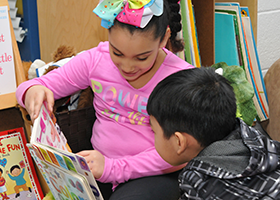- Anne Arundel County Public Schools
- Park Elementary School
-
School Renovation Details - Park Elementary was a complete renovation which resulted in a new building. The building was transformed from a two story building to all one floor. In 2018, Park Elementary received an early childhood wing that included six new classrooms. These classrooms are used for pre-k and kindergarten students.
DEMOGRAPHICS YEAR SCHOOL OPENED 1943 ATTENDANCE RATE (%) 93.7 student Enrollment 479 Race/Ethnicity (%) African American....................... 25.2 Hawaii/Pac. Islander.......................... - White.............................. 34.0 Multiracial...................... 7.0 Hispanic......................... 29.6 American Indian/AK....................... - Asian.............................. 3.6 GENDER (%) Male................................ 50.3 Female........................... 49.7 Special Services** (%) FARMS........................... 83.8 504.................................. 3.0 Special Ed..................... 9.5 LEP................................. 15.1 Title 1............................. Yes
Park Elementary School
Our Key Challenges to Student Success
Reading
-
 The AACPS curriculum redesign including professional development and resources for guided reading instruction, has been of great benefit in our efforts to increase the numbers of students reading on or above grade level. Continued progress monitoring throughout the school year has helped our teachers track our student data more closely and to be responsive to their needs. Despite all of this, our students continue to struggle with reading on grade level text. Teachers look at student data diagnostically to determine which is responsible - accuracy or comprehension - when students do not meet success. Data analysis shows that students in grades 1-5 do not progress to the next level of text largely because they struggle with comprehension. The opposite is observed in Kindergarteners as they struggle to learn letter sound relationships. [Indicators 5, 6]
The AACPS curriculum redesign including professional development and resources for guided reading instruction, has been of great benefit in our efforts to increase the numbers of students reading on or above grade level. Continued progress monitoring throughout the school year has helped our teachers track our student data more closely and to be responsive to their needs. Despite all of this, our students continue to struggle with reading on grade level text. Teachers look at student data diagnostically to determine which is responsible - accuracy or comprehension - when students do not meet success. Data analysis shows that students in grades 1-5 do not progress to the next level of text largely because they struggle with comprehension. The opposite is observed in Kindergarteners as they struggle to learn letter sound relationships. [Indicators 5, 6]While there have been many strategies reviewed to address comprehension difficulties, we have seen success using Anchor charts, Independent Reading Logs paired with Reading Response Journals, Explicit Academic Vocabulary Instruction, Guided Reading Conferencing tailored to individual student needs, Interactive Read Aloud & Explicit Comprehension Lessons, and Active Engagement strategies. PARCC and district assessments in the area of reading continue to call for a need to focus on literature and informational text standard 1. Students in grades 2-5 struggle to answer the Part B portion of questions correctly, which requires students to go back into the text and locate text evidence. Improving student reading levels, building perseverance and stamina should address this issue. Explicit comprehension lessons in grades 3-5 have also really helped to build comprehension skills and improve assessment outcomes. Students also need continued support in test taking strategies to eliminate tricky answer choices and focus on the best answer. [Indicators 5, 6]
-
Clubs & Co-Curricular Activities Faces of AACPS - Stories of Success
Strategic Indicators Chosen by Park Elementary School
Progress we are making on our strategic plan indicators
MSDE Maryland Report Card

